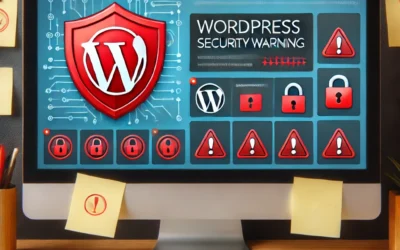When it comes to maintaining a website, ensuring its safety is just as important as making it look good and run smoothly. In this digital landscape, new security vulnerabilities can pop up like weeds in a garden. These vulnerabilities are weak spots that cybercriminals can exploit to gain unauthorized access, steal data, or even bring a website to its knees. Imagine waking up one day to find that your online presence has vanished or been tampered with. That’s a scenario no business owner wants to face. Safeguarding your website from these threats is like putting a lock on your front door—it’s a basic but necessary measure to keep it safe.
The risks posed by security vulnerabilities are not just about the immediate threats but also the impact they can have on customer trust and business reputation. A website that’s left unprotected is like an open invitation for troublemakers who are just waiting to pounce. It’s necessary to stay ahead of these threats and ensure that preventive measures are in place. If you can maintain the security of your site, you’ll not only protect your assets but also preserve the trust and loyalty of your visitors.
Identify Security Vulnerabilities
Understanding how to spot security vulnerabilities is key to protecting your website. These weaknesses can come in various forms, and knowing what to look for helps you act swiftly. Here’s a breakdown of common vulnerabilities and how you can detect them:
– Outdated Software: Using old software versions is like leaving your door unlocked. Hackers often exploit known flaws in outdated plugins or themes. Regularly updating your software ensures that security patches fix these issues.
– Weak Passwords: Simple or reused passwords are easy prey for attackers. Implementing strong, unique passwords adds a layer of protection that can thwart unauthorized access.
– Unsecured Data Transfer: If your website isn’t using HTTPS, data exchanged between your site and users can be intercepted. Ensuring a secure protocol means no eavesdropping on sensitive information.
To detect these vulnerabilities, take advantage of the tools and methods available:
1. Security Plugins: Install plugins that scan your website for known vulnerabilities and notify you of potential risks.
2. Regular Audits: Schedule regular reviews of your site’s security settings. These audits can reveal hidden weaknesses that you might not notice otherwise.
3. Vulnerability Scanners: Use dedicated scanning tools that provide detailed reports on the security status of your site and recommend actions to bolster defenses.
Being aware of these vulnerabilities and actively monitoring your site for threats is a proactive approach that positions you to act quickly, maintaining peace of mind regarding your website’s security integrity.
Immediate Steps to Take
Once a vulnerability is discovered, acting swiftly is important. Think of it like noticing a small crack in a dam—ignoring it can lead to more significant problems down the line. Here’s a guide on immediate actions to take:
– Isolate the Problem: As soon as you identify a vulnerability, isolate the affected area of your website. This helps prevent the issue from spreading and causing further damage.
– Apply Updates and Patches: Developers often release updates in response to newly discovered vulnerabilities. These updates include patches that fix the security flaws. Regularly checking and applying these updates as soon as they become available helps close off potential entry points for hackers.
– Backup Your Website: Having a recent backup allows you to restore your website to a secure state if any issues arise. Make it a habit to back up your site regularly, so you always have access to clean copies.
Keeping these steps part of your immediate response plan ensures that your website remains as protected as possible when vulnerabilities are uncovered.
Strengthening Security Measures
Beyond immediate fixes, reinforcing your website’s overall security measures helps create a strong defense system. It’s like building a strong castle with high walls and a secure gate. Here are practical steps to strengthen security:
– Use Secure Website Hosting Services: Choosing a secure hosting provider safeguards your site with infrastructure designed to thwart attacks. Look for hosts that provide strong security protocols and regular monitoring.
– Implement Firewalls and Security Plugins: Firewalls act as gatekeepers, monitoring and controlling incoming and outgoing traffic based on predetermined security rules. Security plugins add an extra layer of protection by regularly scanning your site for suspicious activities and blocking them.
– Conduct Regular Security Audits: Regular audits help identify weaknesses before they turn into bigger problems. Schedule assessments to check for outdated software, weak passwords, and other issues that compromise security.
Integrating these practices into your routine operations sets your website on a path toward sustained protection.
Long-term Strategies for Security
Building a long-term security strategy is akin to creating a well-oiled machine that runs smoothly over time. These strategies ensure you are not just reacting to vulnerabilities but proactively defending against them:
– Adopt Best Practices: Implement security best practices like using SSL certificates, keeping all software updated, and maintaining strong password policies.
– Educate Your Team: Make sure your team is aware of security risks and understands how to recognize potential threats. Training sessions and workshops can be beneficial in keeping everyone informed about the latest security practices.
– Develop an Ongoing Security Plan: Plan for regular reviews and assessments that adapt to new threats as they emerge. This plan should include routine updates, scheduled backups, and a clear protocol for responding to incidents.
Safeguard Your Website for Peace of Mind
Ensuring your website is secure offers peace of mind, knowing that you’ve taken every possible step to protect your online presence. By staying vigilant and proactive, you maintain the trust of your visitors and the integrity of your site.
Encourage consistent evaluation and improvement of your security measures. This approach not only shields your website but also fosters a reliable and secure digital environment for all users. Your commitment to safeguarding your digital space is a testament to the value you place on both your business and the community you serve.
To truly secure your website against potential threats, consider leveraging secure website hosting services to ensure robust protection. At Eight Hats, we’re committed to offering exceptional security along with unmatched support. Foster a safe and reliable digital environment for your business and its users.




